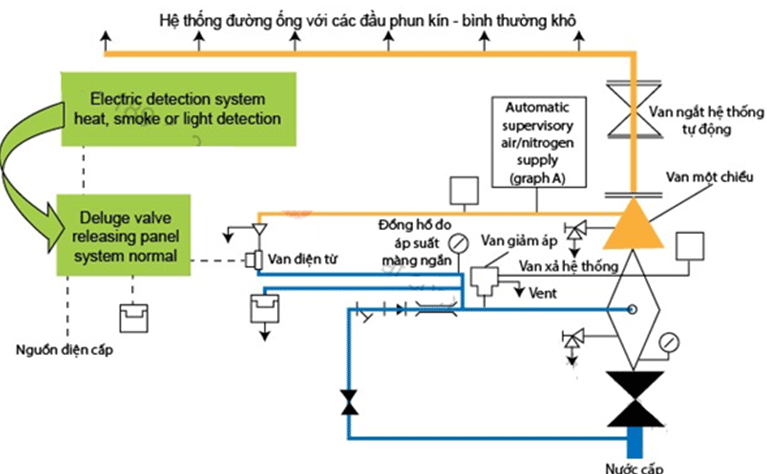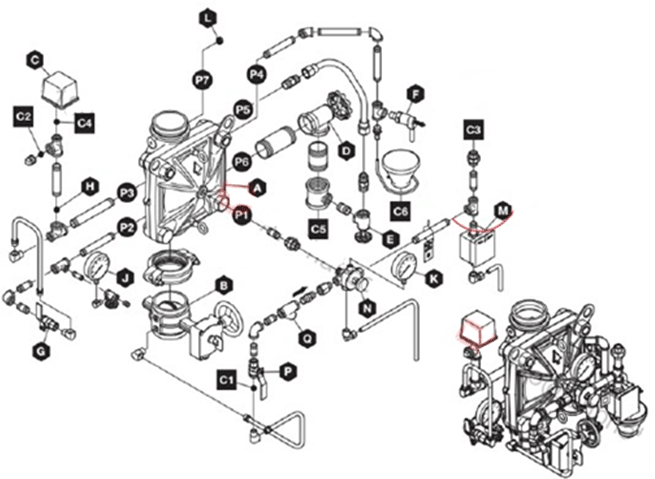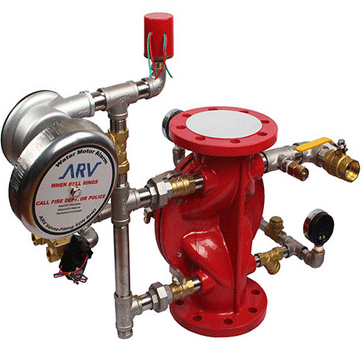Maintenance steps for deluge valves
The maintenance of the overflow valve or deluge valve is very important in the fire protection water supply system, so it needs periodic maintenance to help the system operate more smoothly.
For supply water pressure (J) lower than normal:
Note: in case the supply water pressure drops (possibly due to a water line rupture or under repair), then the pressure drop in the diaphragm chamber (due to a leak in the diaphragm chamber, a leak on the conduit pipe, etc.) connector or check valve)

Các bước bảo trì van xả tràn, van deluge
The following maintenance steps for overflow and deluge valves we will share with you, let's refer together.
Immediately close the main control valve (B) and perform the following steps to reset the system:
Step 1: Before the supply water pressure recovers, close the main control valve (B) and observe whether the supply water pressure gauge (J) is within the allowable range.
Step 2: If the diaphragm chamber pressure is lower than normal, check for leaks (if any) from the diaphragm chamber before resetting the system.
Step 3: After the supply water pressure is restored (J), proceed to reset the system as instructed in the tyco deluge valve setting.
Alarm flow test:
To check alarm flow open alarm check valve (G). It then allows water to flow through the pressure switch (C) and the alarm. After completing the test, close the check valve (G). To ensure that the water is completely drained from the alarm pipe, press the button on the automatic drain valve (F).

Check operation of wet-activated deluge valve:
To confirm the deluge valve is working properly perform the following steps:
Step 1: If you want to prevent water from flowing out, do: Close the main system control valve (B). Open the main drain valve (D). Open the main system control valve (B) past the position where water begins to flow out at the main drain valve (D). Close the main drain valve (D) slowly.
Step 2: Open the “Inspector’s Test Connection” suite:
Step 3: Observe the amount of water entering the system.
Step 4: Close the main system control valve (B).
Step 5: Close the water supply valve to the diaphragm (P).
Step 6: Reset deluge valve.

Check the operation of the dry-activated overflow valve:
To confirm that the overflow valve is working properly, perform the following steps:
Step 1: If you want to prevent water from flowing out, perform: Close the main system control valve (B). Open the main drain valve (D). Open the main system control valve (B) past the position where water begins to flow out at the main drain valve (D). Close the main drain valve (D) slowly.
Step 2: Open the “Inspector’s Test Connection” suite.
Step 3: Observe the amount of water entering the system.
Step 4: Close the main system control valve (B).
Step 5: Close the water supply valve to the diaphragm (P).
Step 6: Reset overflow valve.
To confirm that the overflow valve is working properly, perform the following steps:
Step 1: If you want to prevent water from flowing out, perform: Close the main system control valve (B). Open the main drain valve (D). Open the main system control valve (B) past the position where water begins to flow out at the main drain valve (D). Close the main drain valve (D) slowly.
Step 2: Activate the fire control cabinet system to open the solenoid valve.
Step 3: Observe the amount of water entering the system.
Step 4: Close the main system control valve (B).
Step 5: Close the water supply valve to the diaphragm (P).
Step 6: Reset deluge valve.
Check the operation of the gas actuating valve (Dry Pilot Actuator):
To confirm that the gas actuating valve is working properly perform the following steps:
Step 1: Close the main system control valve (B).
Step 2: Open the main drain valve (D).
Step 3: Open the “Inspector’s Test Connection” suite.
Step 4: Confirm there is flow from the gas-activated valve set (R).
Step 5: Confirm that the diaphragm chamber pressure drops below 25% of the supply water pressure.
Step 6: Close “Inspector’s Test Connection” and re-pressurize the trigger pipe by:
+ Water will stop flowing from the air-activated valve set (R) but will still flow out at the manual resetter (N).
+ Press and hold the reset button (N) until the water stops flowing.
The pressure will increase in the diaphragm chamber.
After the pressure in the diaphragm chamber recovers, check for leaks in the gas trigger (R) and resetter (N). The leak (if any) must be resolved before moving on to the next step.
Step 7: Partially open the main control valve (B). Close the main drain valve (D) slowly as soon as water is released from the main drain valve (D). Observe for leaks in the automatic drain valve (F), if there is a leak, proceed to handle it, if there is no leak, the overflow valve is ready to operate and fully open the control valve (B).
Conclusion : The maintenance steps of the overflow valve, deluge valve we share with you to understand more about the importance of regular maintenance to help us ensure the best operation.

Have 0 comment, evaluate about Maintenance steps for deluge valves
TVAdministratorsAdministrators
Welcome, honored guests. Please leave a comment, we will respond soon